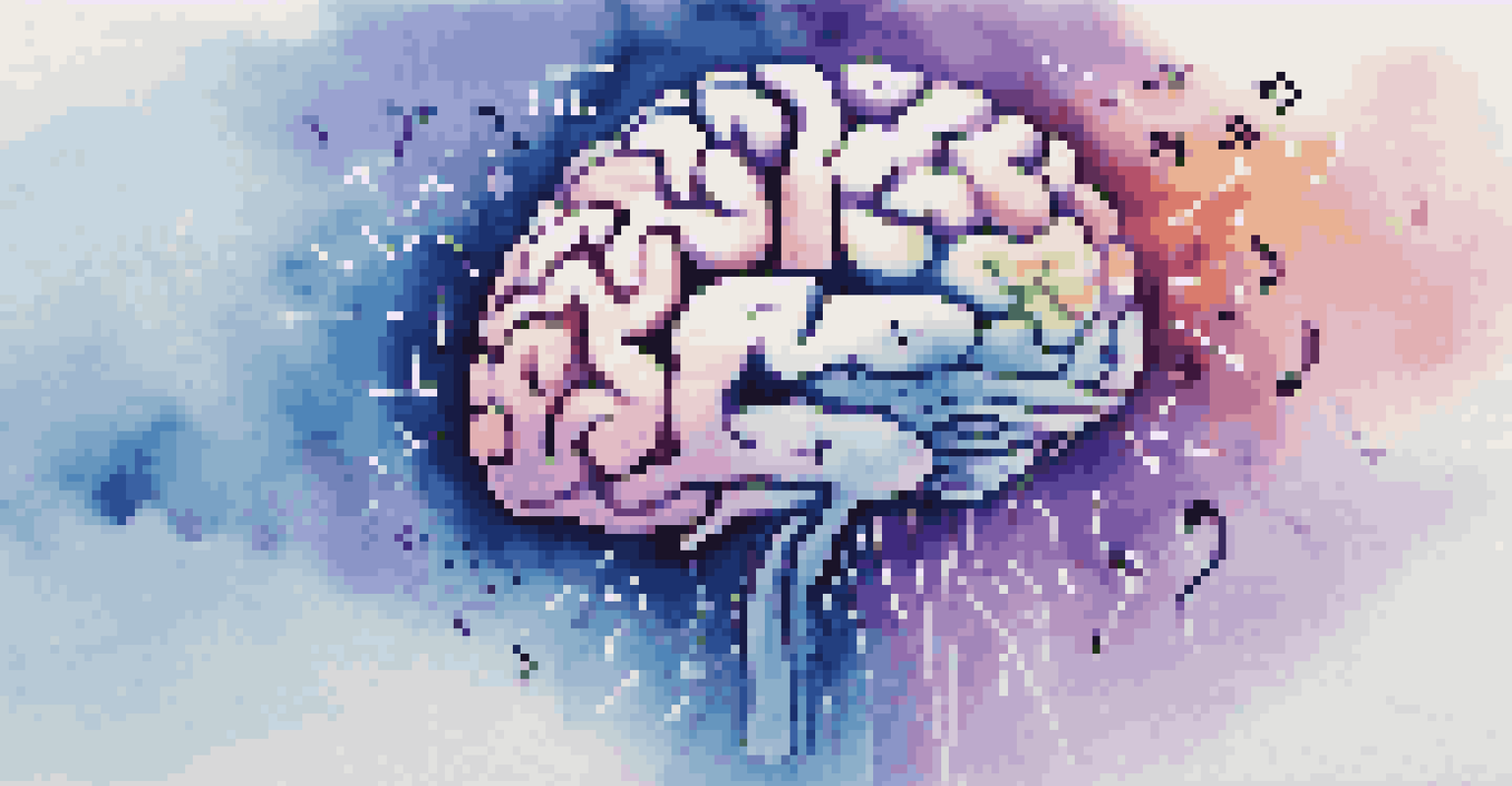Music as Medicine: Healing Strategies in Community Health

Understanding Music's Therapeutic Power
Music has a profound impact on our emotions and mental state, acting as a universal language that transcends barriers. Studies show that listening to music can reduce stress and anxiety, promoting a sense of calm. This therapeutic power isn't just anecdotal; it's backed by research indicating that music can even lower cortisol levels, the hormone associated with stress. Essentially, music can serve as a powerful tool for emotional regulation in a variety of settings.
Music can change the world because it can change people.
For instance, many hospitals now incorporate music therapy into their patient care programs, recognizing its ability to aid recovery. Patients often report feeling more relaxed and less pain when music is part of their treatment. This illustrates how music can create a positive atmosphere that fosters healing, making it an essential component of holistic health strategies.
Moreover, the versatility of music allows it to be tailored to individual preferences, making it a personalized healing strategy. Whether it's classical, jazz, or even pop, different genres can evoke different emotions and reactions. This adaptability makes music a valuable resource for healthcare providers seeking to enhance patient experiences and outcomes.
Music Therapy: A Structured Approach to Healing
Music therapy is a formalized practice that utilizes music interventions to achieve specific therapeutic goals. Certified music therapists design sessions that address the physical, emotional, cognitive, and social needs of individuals. This structured approach ensures that music is not only enjoyed but also serves a defined purpose in the healing process, whether it's enhancing communication skills or improving motor functions.

For example, in rehabilitation settings, music therapy has been used to help stroke patients regain speech and movement. By engaging with rhythm and melody, patients can stimulate brain areas associated with these functions. This connection between music and brain activity highlights the potential of music therapy as a complementary treatment alongside traditional methods.
Music Reduces Stress and Anxiety
Listening to music can lower cortisol levels and promote relaxation, making it a powerful tool for emotional regulation.
Additionally, music therapy can be beneficial in helping individuals cope with trauma or chronic illness. By providing a safe space for expression, music allows patients to process their feelings and experiences. This therapeutic relationship between the therapist and patient, facilitated through music, can foster resilience and promote emotional healing.
Community Programs: Bringing Music to the Masses
Community health initiatives increasingly recognize the value of music in promoting wellness. Programs that incorporate music—such as community choirs, drumming circles, or music workshops—are popping up across various neighborhoods. These participatory activities not only enhance individual well-being but also strengthen social bonds, creating a sense of belonging and support among participants.
Where words fail, music speaks.
Take, for instance, programs in underserved areas where access to traditional healthcare services may be limited. By offering music-based activities, these programs foster community engagement and provide a creative outlet for self-expression. Participants often report improved mood and lower stress levels, demonstrating how music can serve as a vital component of community health.
Furthermore, these initiatives can break down barriers to healthcare access. By integrating music into community health strategies, organizations can reach individuals who might otherwise feel isolated or disconnected. This inclusive approach helps ensure that everyone can benefit from the healing power of music, regardless of their background.
The Science Behind Music and Mood Regulation
Research in neuroscience has unveiled fascinating insights into how music affects our brains. When we listen to music, our brains release neurotransmitters like dopamine, often referred to as the 'feel-good hormone.' This chemical response can elevate our mood and even alleviate feelings of depression or anxiety, making music an effective ally in mental health care.
Furthermore, different types of music can elicit various emotional responses. For example, upbeat tempos can energize and motivate, while slower melodies can help us unwind and reflect. Understanding these dynamics allows therapists and healthcare providers to choose appropriate music that aligns with their patients' emotional states and goals.
Music Therapy Aids Recovery
Structured music therapy interventions help individuals regain skills and cope with trauma, enhancing overall healing processes.
This scientific foundation strengthens the case for incorporating music into health interventions. By recognizing music's role in mood regulation, we can better harness its benefits in therapeutic settings, ensuring that patients receive the most effective care possible.
Cultural Significance of Music in Healing Practices
Throughout history, music has played a vital role in various cultures' healing practices. From ancient rituals to modern therapies, music has been used as a tool for spiritual and physical healing across the globe. Different cultures utilize unique musical elements, such as chants, instruments, and rhythms, to connect individuals with their heritage and promote well-being.
For example, Indigenous cultures often incorporate drumming and singing in their healing ceremonies, believing that music can restore balance and harmony. These practices reflect a deep understanding of music's power and its ability to facilitate emotional and spiritual healing. By acknowledging and respecting these cultural traditions, modern health practices can enhance their approaches to community health.
This cultural significance underscores the importance of integrating diverse musical influences into contemporary healing strategies. By doing so, we not only honor these traditions but also provide a richer, more inclusive healing experience for individuals from various backgrounds.
Challenges and Considerations in Music-Based Interventions
While the benefits of music in healing are clear, there are challenges to consider when implementing music-based interventions. One key challenge is ensuring that the music chosen resonates with all participants, as individual preferences can vary significantly. It's essential for therapists and facilitators to understand their audience and curate music that will engage and uplift them.
Additionally, some individuals may have negative associations with certain types of music or specific songs. This underscores the necessity for careful selection and open communication with participants about their preferences. By fostering an environment where individuals feel comfortable sharing their thoughts, facilitators can create a more effective therapeutic experience.
Community Programs Foster Connection
Music-based community initiatives enhance well-being and social bonds, providing creative outlets for self-expression and support.
Moreover, access to quality musical resources can be a limitation in some community settings. Ensuring that programs have the necessary instruments and technology can be crucial for success. By addressing these challenges, health organizations can pave the way for more effective and inclusive music interventions in community health.
Future Directions for Music in Community Health
The future of music as a healing strategy in community health appears promising. As more research highlights the benefits of music on mental and physical well-being, we can expect to see a growing integration of music-based interventions in health care settings. This trend will likely lead to innovative programs that focus on preventative care and holistic approaches to health.
Moreover, advancements in technology may enable new ways to access and participate in music therapy. Virtual platforms can connect individuals with music therapists, regardless of geographical limitations. This accessibility can expand the reach of music therapy, allowing more people to experience its healing benefits.

Ultimately, as communities continue to embrace the role of music in health, we can anticipate a shift towards more inclusive and engaging health strategies. By recognizing the importance of music in well-being, we can work towards a healthier future for all, where the power of music plays a central role in enhancing quality of life.